By Rich Small, Partner, The Small Agency
Trying to compare thin film amorphous silicon PV laminates with crystalline solar panels for a standing seam metal roof application is like asking who plays better baseball—the New York Yankees or the Boston Red Sox.
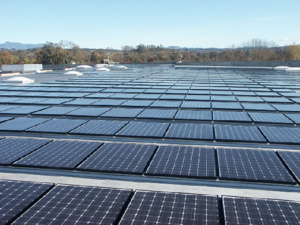 | |
There is no singularly superior method of integrating photovoltaic systems with metal roofing. There are, however, two proven methods – thin film amorphous silicon PV laminates (shown below) and crystalline solar panels (shown
above). Determining which is best for a given application depends largely on factors related to the project itself. Click images to enlarge. |  |
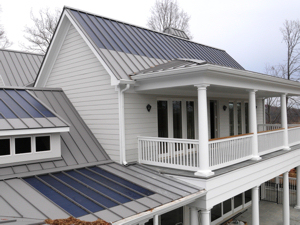
| |
Just raising the topic is sure to draw every zealot out of the woodwork into contentious arguments supported by a stack of stats and data. And those arguments can – and have – been going on for years.
So let the fans argue. Because, despite claims of clear cut winners from both camps, when it comes to choosing a system for a standing seam metal roof, the answer is easy – both can be good.
The concept of combining photovoltaic arrays with standing seam metal roofing is growing – and for good reasons. A standing seam metal roof has a life expectancy consistent with that of framed and laminate photovoltaic systems. A 30-year power
source on a 30-year roof, along with zero-penetration technology creates the most sustainable roof system available with alternative power generation, all without compromising the roof's warranty.
But your first question when considering either technology shouldn’t be which is cheaper or which produces more power based on manufacturer specifications. The first question should be – where is your roof?
Variables including space, climate, sunlight and design aesthetics, along with price and product specification, should also dictate which is the suitable photovoltaic choice for a standing seam metal roof.
For example, if you’re structure is in an area of bright, continuous sunlight, then crystalline silicon will probably win. If you’re trying to maximize the solar capabilities of a small roof area, then crystalline silicon will probably
do better than thin film.
| | 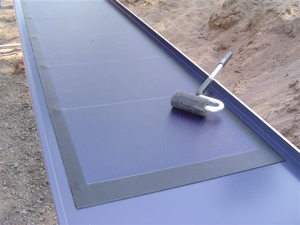
|
| | Thin-film laminates have a peel and stick backing that enables them to be attached to the metal roofing panels in the shop or at the job site. Crystalline panels, meanwhile, are attached to the roof using non-penetrating clamps that
are secured to the roof's seams. The clamp shown below is the S-5-PV clamp from S-5!. |
| | 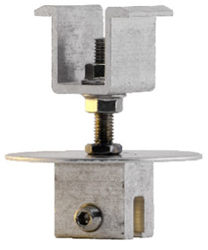 | |
| | |
Conversely, if your building is in a lower sunlight area, either because of climate or other influences such as shade patterns cast by trees and adjacent structures, then thin film laminates will probably deliver more power. And if you have plenty
of roof space, then thin film will probably deliver better results for your money.
There are no apples to apples comparison with these two technologies when installed on a standing seam metal roof. A crystalline system, requiring framing and clamps that attach to the seam of the standing seam metal roof, will cost more than an adhesive-backed
photovoltaic laminate which can be applied directly to the panel of the standing seam. But because it takes more laminate material to produce amounts of energy comparable to a crystalline configuration, more connections must be installed with
the laminate system – negating any substantial installation savings from the simple peel and stick process.
Many standing seam roofs today are available with cool roof coatings that are ENERGY STAR approved and LEED compliant. These designations mean the roofs have high solar reflectivity and emissivity that can keep the interior of a building cool in summer.
In sunny, warm weather conditions, a crystalline PV system further reduces the heat factor by shading the roof with its panels. PV laminate does not have that ability.
Conversely, photovoltaic laminates work better in cloudy, low-light environments and shade, capturing different light wavelengths and allowing current to flow around shaded areas of the laminate. Laminates will perform better in coastal fog, hazy,
overcast conditions and in industries where there is a lot of airborne dirt and particles.
Unlike crystalline systems which reach their stable rated output immediately, laminates can take up to a year to reach a stable, rated output. After stabilization, both materials degrade at similar rates up to one per cent a year. Unless, of course,
if dirt or debris were to cover both materials or they become damaged. In which case, laminates will continue to have a greater output.
All photovoltaic systems experience a reduction in power with an increase in cell temperature. This effect is less pronounced for PV laminates – about a three percent difference, making laminates a better choice for warmer (notice we didn’t
say sunny) climates and larger roof surfaces.
Clearly, the cost of installation is going to vary with every project. There is no apples-to-apples data when comparing crystalline and amorphous silicon. There are several amorphous film and crystalline products currently available in the marketplace.
And each has slightly different characteristics that make it difficult to compare the output capacities of thin film to crystalline head to head. However, there are some differences not related to output.
For example, unlike the crystalline technology, thin film photovoltaics can be easily applied to curved metal roof surfaces.
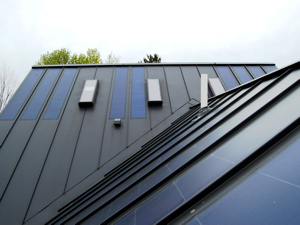 |
While metal roofing is available in virtually any color under the sun, PV laminates are not. To hide them on the roof, designers often match them with darker colors of roofing. Shown above is a 130-year-old home in East Newburyport,
MA, featuring a new metal roof and PV system. Below is a 9,500 sq. ft. home in Windham,NH, featuring a PV-integrated metal roof system with solar thermal heating beneath. Shown at the bottom is the Steele Barn in Litchfield, CT.
The PV system was installed as a replacement for propane as a backup power source. Click images to enlarge. |
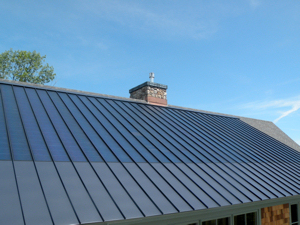 |
| |
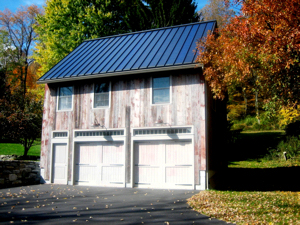 |
Homeowners and architects concerned about aesthetics and maintaining the appearance of a traditional roofing surface may be willing to sacrifice the crystalline panels for the laminates. The latter are applied directly to the standing seam panel and
on dark roof colors are hardly discernable from ground level. Just as Henry Ford once told the American consumer that he could have a car painted any color he wanted so long as it was black, the same American consumer can have a thin film laminate
any color he or she wants so long as it is dark blue. Consequently, it works aesthetically with dark colored roofs like dark blues and greens, black, dark bronze and charcoal gray – but will be obvious from ground level with roof coatings
like reds, whites and tans. Englert Inc. sells a PV laminate product called SunNet and has been producing a standing seam product coated with SunNet Blue in an effort to match the color of the laminate to the standing seam material.
One of the other concerns of solar roofing is wind uplift, particularly in the Southeastern United States where hurricanes are an annual concern. Tougher wind standards have been implemented in the building codes of nearly every southern state and
most are modeled on the standards set by the Miami-Dade and Florida Building departments as well as FM uplift testing, UL Uplift Standard 580 and ASTM 1592 uplift standards. Many standing seam metal roofing systems meet the material requirement
for these standards. Homeowners contemplating the use of standing seam with PV laminates in hurricane areas should investigate which combinations of standing seam profiles and PV laminates meet the Miami-Dade code.
We know of no independent third party testing where crystalline panels attached to standing seam have met the wind uplift requirements of the Miami-Dade and Florida Building departments. S-5!, a company that provides metal rooftop attachment solutions,
has introduced a clamp for securing framed photovoltaic modules to standing seam metal roof systems. The clamp fits the majority of solar panels on the market including hidden and exposed seam and corrugated material. The system has held
secure in real and simulated wind conditions of up to 145 miles per hour, according to an S-5! spokesperson. And the company strongly suggests installers use an S-5! PV clamp to attach a crystalline module every time you cross a standing seam.
It should also be emphasized that a sturdy product makes up only one aspect of a hurricane resistant roof. If you want the soundest defense against the fury of Mother Nature then you should have an American Society of Consulting Engineers (ASCE) analysis
to specify the most storm-proof construction, a weather tightness warranty from the roofing material manufacturer with onsite installation inspections, the services of a certified installation contractor who will properly install the roof and
supervision by an architect with experience in metal roof and solar installation.
A lot of experts and potential users have been comparing crystalline and thin film technologies based on price and output. It’s clear there are a lot of other issues that must be considered with equal gravity before a decision is made.
 |
Rich Small, Partner
The Small Agency |
Richard Small has been a marketing communication consultant for more than 30 years, providing senior counsel to such building products suppliers as Tyvek, Teflon, Trex, Cyro Industries, Red Devil and Suburban Propane. He has served as marketing communications counsel to Englert Inc. on its metal roofing, rainware and environmental building products lines for nearly a decade. Prior to entering the marketing communications industry, he was a daily newspaper reporter.